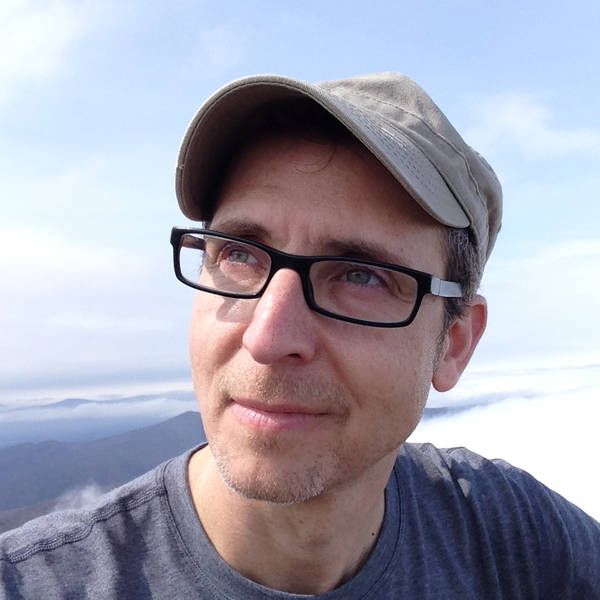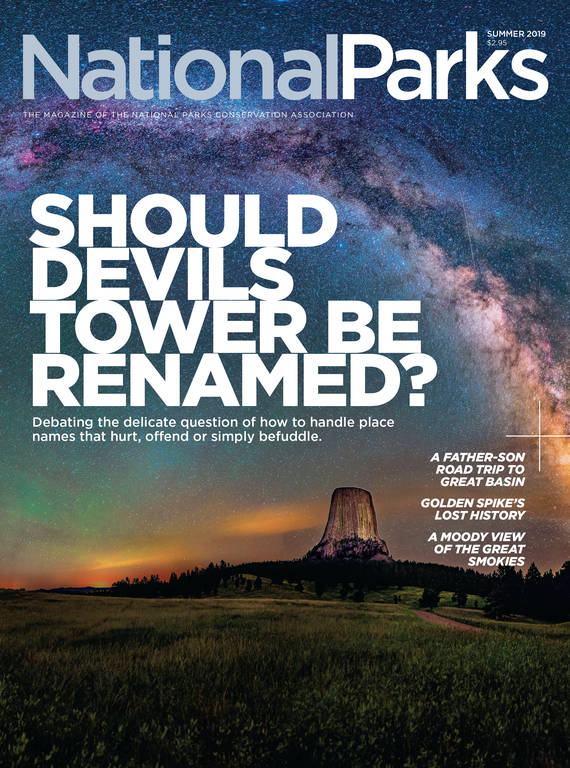Summer 2019
Walking the Walk
Sixty-five years ago, park advocates joined a Supreme Court justice on an epic hike to save the landscape he loved.
Whenever he needed to think deeply about a case before the Supreme Court, Associate Justice William O. Douglas would take a long walk on the towpath of the Chesapeake and Ohio Canal.
For Douglas, the C&O was a haven from the trappings of life in Washington, D.C., and a place to uplift his spirit amid the forests and falls of the Potomac River. To maintain his health, which had been poor during his childhood, he was accustomed to walking 15 or 20 miles on the towpath on a Sunday afternoon. So he was incensed to read, in the Jan. 3, 1954, edition of The Washington Post, an editorial in support of a proposal to pave over the canal — “no longer a commercial or scenic asset,” the paper claimed — and turn it into a parkway.
“The basic advantage of the parkway is that it would enable more people to enjoy beauties now seen by very few,” wrote Merlo Pusey, an editorial writer.
Douglas, however, was of the opinion that zooming by those beauties at 60 miles per hour was pointless. The wonders of the canal’s landscape were to be enjoyed slowly and intimately, he believed, and he penned his own letter, which ran on Jan. 19, 1954, in response.
“It is a refuge, a place of retreat, a long stretch of quiet and peace at the Capitol’s back door — a wilderness where man can be alone with his thoughts, a sanctuary where he can commune with God and with nature, a place not yet marred by the roar of wheels and the sound of horns,” he wrote.
He also challenged Pusey to walk the entire length of the canal with him to see firsthand why it was worthy of protection. If he did, Douglas wrote, “he would return a new man and use the power of your great editorial page to keep this sanctuary untouched.”
Stretching nearly 185 miles along the Potomac River from Cumberland, Maryland, to Washington, D.C., the C&O Canal bustled with commercial activity for much of the 19th century. Mule-drawn boats carried coal, food and building supplies between the nation’s capital and developing regions to the west. But by the 1920s, the last of the boats had been unloaded, and in 1938, the abandoned canal and its towpath were acquired by the federal government.
Various plans for the canal fell by the wayside during the Second World War, but postwar prosperity and a national wave of road-building led to a National Park Service proposal, approved by Congress, to pave the C&O — the project supported by the Post.
The National Parks Conservation Association — still known as the National Parks Association at the time — analyzed the proposal and opposed it, recommending instead that the historic waterway and adjacent land be preserved and protected from development, a position shared by The Wilderness Society. Their efforts to safeguard the canal would soon be swept up and amplified by a media sensation.
Pusey — and Robert H. Estabrook, editorial page editor for The Post — accepted Douglas’ challenge, agreeing to accompany him and hike the full length of the canal. On the morning of March 20, 1954, just after steady overnight rains had abated, a group gathered in Cumberland and hit the trail. Thirty-seven walkers began the trek — including NPA President Sigurd Olson, NPA trustee and Wilderness Society President Olaus Murie, and Anthony Wayne Smith, an NPA trustee who would lead the organization from 1959 to 1980 — and the number soon grew to 58. A cadre of cameramen and journalists followed the group, including Aubrey Graves, who chronicled each day’s progress in dispatches for the Post, even documenting with wry humor the abrasions and sore feet sustained by his colleagues at the paper.
There was good reason for the blisters. The 55-year-old Douglas set a brisk pace, leading the party 22 miles on the first day — and never slowing down. Over the eight-day hike, the group averaged more than 23 miles per day, through weather fair and foul. As the walk progressed, national interest continued to rise, and stories appeared everywhere, from Time magazine to movie theater newsreels.
But it wasn’t just a walk in the park. The number of walkers steadily dwindled as fatigue and discomfort mounted, and even the experienced Douglas developed a case of poison ivy rash. To keep spirits high, Olson led the wayfarers in song at their camp each night, adding several verses about the day’s events to the singalong he was composing. By the eighth day, “The Canal Song” included more than 30 verses.
Excitement grew as the weary party neared Washington. At Fletcher’s Cove, less than 3 miles from the journey’s end, Interior Secretary Douglas McKay doffed his hat and greeted Douglas. In Washington’s historic Georgetown neighborhood at the terminus of the canal, a throng of supporters awaited the hikers and welcomed them with cheers.
In the end, only Douglas and eight companions completed the entire hike — the so-called “Immortal Nine,” including NPA’s Murie. And just as Douglas had predicted, Pusey and Estabrook were moved by what they had experienced and reversed their positions in a subsequent editorial. The Park Service proposal was dropped in 1956.
The Douglas hike galvanized national support for the preservation of the C&O Canal, but many years of advocacy followed before its protection was secured. In 1961, President Dwight Eisenhower used his power under the Antiquities Act to designate the stretch of canal from Cumberland to Seneca, Maryland, a national monument, but it wasn’t until 1971, after a series of contentious proposals and bills had come and gone, that an act of Congress created Chesapeake and Ohio Canal National Historical Park, protecting the entire length of the canal and surrounding lands.
In 1977, the canal and towpath were officially dedicated to Douglas. To this day, his bust stands near Lock 3 of the C&O Canal in Georgetown, and the park now welcomes between 4 million and 5 million visitors annually, thanks in no small measure to Douglas and his companions.
“They understood that once paradise was paved, something ineffably precious would be lost forever,” said Robin Zanotti, president of the nonprofit C&O Canal Trust. “We who have come after them owe them an enormous debt of gratitude. Because they literally ‘walked the walk,’ we can escape our hurried and mechanized world and enjoy nature in ‘slow time’ — on foot, on horseback or on a bike.”
Yesterday on the C&O Canal
By Robert B. Keiter
Little did I know as a youngster that my “backyard” was soon to become a national park. I grew up in Glen Echo, a small Maryland town on the outskirts of Washington nestled on a hillside next to the Chesapeake & Ohio Canal and the Potomac River. During the country’s postwar years, a rapidly growing population was expanding into suburban enclaves encircling our major cities. My parents, following their wartime military service, had settled in the Washington area rather than return to the moribund Pennsylvania coalfields of their youth.
Though only 6 years old at the time, I still vividly recall our initial family outings to the canal, a remarkable natural setting only a few hundred feet downhill from our house. The experience hooked me on the canal and all that it offered. This being the 1950s, my parents placed few restraints on me, so after school and during the summer, my friends and I regularly headed to the canal and river to fish, camp and explore. It was an early childhood filled with the wonders of nature and the freedom of the outdoors. And I assumed it would last forever.
One day, though, I overheard my parents talking with neighbors about a proposed highway, which I soon understood could threaten the canal, towpath and homes in our town. Just as I was establishing a love for the natural world outside my back door, the battle to preserve the C&O Canal began.
My childhood memories of the controversy, which extended over the next 15 years, are fragmentary. I remember seeing the front-page photo in The Washington Post of Supreme Court Justice William O. Douglas and hearing about his monumental effort to protect the canal and river. Eventually, I learned about the plan to build a parkway to the city, an idea originally conceived in 1901. Sixty years later, President Eisenhower invoked the Antiquities Act to protect the canal between Seneca and Cumberland as a national monument, but he left out the lower stretch of the canal beside Glen Echo.
As a young teenager, I sadly bore daily witness to construction of the George Washington Memorial Parkway, later renamed the Clara Barton Parkway. Neighbors within a stone’s throw of our house, following eminent domain proceedings, were forced from their homes to open a passageway for the parkway on the steep hillside leading down to the canal. Giant bulldozers followed, carving a roadbed that separated our home from the canal.
Finally, Congress adopted legislation establishing Chesapeake and Ohio Canal National Historical Park in 1971. By then, the parkway was completed, leaving a permanent scar along stretches of the canal. Today, the road accommodates a steady rush of cars that shatter the stillness of the canal I knew as a youngster. Yet the creation of the park was a major conservation victory: It protected the entire length of the canal, ensuring that my childhood sanctuary would not be further disturbed and that others would have the opportunity, as I did, to experience this special landscape just a few miles from the nation’s capital.
This formative childhood experience instilled in me a lifelong appreciation for the natural world and an understanding of how fragile these places are in the face of progress. Perhaps not surprisingly, much of my professional life has involved protecting our national parks and related nature conservation efforts. My “backyard” is bigger these days, but the pull of the canal is still strong, and I regularly visit the area when in town from my home in Utah. These occasions always evoke a flood of memories, and it gives me great pleasure to see so many people out strolling the towpath or biking or navigating their kayaks through the river’s roiling waters.
BOB KEITER serves on the NPCA board of trustees; he is the Wallace Stegner Distinguished Professor of Law at the University of Utah and author of “To Conserve Unimpaired: The Evolution of the National Park Idea.”
About the author
-
 Todd Christopher Senior Managing Director, Digital & Editorial Strategy
Todd Christopher Senior Managing Director, Digital & Editorial StrategyTodd guides NPCA's publishing and content strategy and leads the team that produces our website, magazine and podcast. He is also the author of The Green Hour: A Daily Dose of Nature for Happier, Healthier, Smarter Kids.



